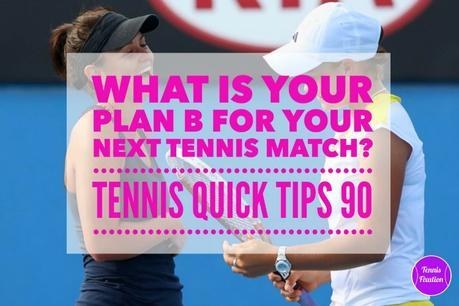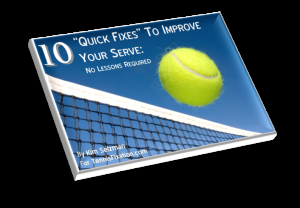Podcast: Play in new window | Download
Do you have a "Plan B" for every tennis match you play? If not, you need to get one and soon. Because the way you like to play tennis, the style of play that highlights your strengths and downplays your weaknesses, may not necessarily be the style of play that is going to win you the match. In this week's episode of Tennis Quick Tips, I'm talking about the importance of having more than one strategy to win a match. You can listen to this episode by clicking on the media player above or by listening in with your favorite podcast app. You can also subscribe in iTunes by clicking on this link: tennisfixation.com/itunes.

SHOW NOTES AND EDITED TRANSCRIPT:
In this week's episode we're going to talk about an aspect of the mental game. I got a question a few months ago from a listener, and Tennis Fixation follower. Her name's Jodi, and we've had several great exchanges.
And the topic she raised was a really good one, one that I myself have had struggles with on occasion. And then Jodi brought this up, and it happened to me right at the time I was trying to come up with a good answer for her. So I wrote her an answer and I really thought this is something that I know my Tennis Quick Tips listeners would like to hear because it's something I bet many of them have faced and probably also have struggled with on court.
When Playing One Point at a Time Isn't Enough
So first I'm going to read you the email I got from Jodi. It says: "Hi Kim, thank you for everything you do. I love reading and listening to you. I have a question, in your recent podcast partly addresses it, but I'd like to know how I can support my partner when things start to go badly for us. You know those matches where you play a blinder and win 6-0. And then fall into a major funk in the second or third set. What do you do when you start to make errors? And what do you say to your partner to support them when they make errors too. One point at a time, one game at time, sometimes just isn't enough. Thanks again, Jody."
Well, shortly after I got that email from Jodi, and I was thinking about it a lot, because I wanted to say something really good to her, I had that exact same situation occur for me. So, I'm going to read you my reply, and if necessary I'll throw in some extra comments and then at the end I'll comment a little bit further on it.
What I told her was: "Jodi, I've been thinking about your question for a while and then yesterday it happened. My partner and I won the first set 6-0, lost the second set 4-6, and then barely won the third set 6-4. And I agree with you, play one point at a time is great advice, but after you've been telling each other that for a while, like well into the second set, it's not too helpful. And that is certainly not what we did to make it through those last two sets.
How I Adopted a Plan B in My Tennis Match
So here's what happened with me, and what me and my partner did. In my match yesterday both teams were playing their plan A when they came out on court. Our Plan A was to play aggressively at the net as much as possible. Our opponent's plan A seemed to be just to get the ball back and try not to make errors. So after the first set I know they realized that their plan A wasn't working at all.
In the second set they began lobbying us a lot, which frankly was a good idea. We realized it was happening at some point, but didn't do anything about it for quite a while. In other words, they had moved to plan B, lobbying, but we were still playing plan A, both moving in quickly to play aggressive at the net.
It wasn't until about the end of the second set that we admitted we weren't dealing with the lobs very well and needed to make a change ourselves. So at the end of the second set, and into the third set, we moved into our own plan B, which was to not move into the net quite as quickly, and play with one player back mostly, and one player aggressive at the net.
I know this is not the best doubles formation, but we needed to do something about those lobs. This worked for us much better than our plan A, because our opponents just kept up with the lobbying. I guess they didn't have a plan C. And we were able to get really straight between us which one of us was covering what. My partner mostly stayed back, and I mostly covered the net.
So my answer to your question is, when this is happening, you have to know to quickly evaluate the situation, to figure out how it is that your opponents have changed their game, what their plan B is, and you have to be willing and not afraid to put your own plan B into effect. It's definitely not enough to just play one point at a time in these situations. That's a great overall tennis philosophy, but in this situation is not enough.
For the most part, I think making this change to your game is easier to do than it seems. My partner and I had only ever played together one previous time, so it's not like we really had a great feel for each other's games, and we definitely did not have an official plan A and Plan B when we went out on court.
Rather, we were both willing to admit things were going downhill in that second set, and we had to try something very different from what it had been working and from what we both liked to do. We both liked playing aggressive at the net and did not want to stay back.
I'm not sure what we would have done if our opponents had to come up with a plan C. I hope we would have figured it out and come up with own play and C. Fortunately we didn't get there and were able to win just with a plan B. I hope that's somewhat helpful, this is a great topic and I think I'll try to do a podcast on it since, as you point out, when it happens it's hard to know what to do."
Be Mentally Tough and Use Plan B
So that was my response to Jody. And when that situation occurs, where you win that first set easily and then suddenly in the second set things are rapidly going downhill, you really need to think about what has changed in the second set. I think most people playing doubles come out on court and try their plan A, whatever that plan A is, whether you are someone who likes to come in aggressive at the net, whether you're a lobber, whatever it is if you're a great poacher that's what you immediately put into effect and see how it goes against your opponents.
But when it's not working, you really have to be mentally tough and ready to say: "My game that I like to play isn't working, or the game that my partner and I like to play isn't working, and we need to change something quickly, or else this is all going to slip away." But it's a hard thing if you are someone who likes to play a certain way, if you like to be aggressive and come into the net, or if you're someone who likes to stay back and play moon balls and lobs, it can be hard to go against what your natural tendency is or to go against the way that you like to play.
But you have to be ready to do that. So I think you've got to always be ready to put plan B into effect. You can't just go out on court and not think about what is happening out there, not thinking about how your partner and you are having an effect on your opponents.
You've got to be aware of that and if the effect you're having is not a winning effect, that you're winning points, you need to be ready with a backup plan, even if it means playing a style of tennis that you really don't like to play, or putting into effect a formation, which is what we were doing playing one up one back, that isn't necessarily the strongest formation, but it was the one that worked in the situation.
So that's it for this week's Tennis Quick Tip. Remember, don't just go out on court with the plan A, have a plan B and, what the heck, you better maybe have a plan C to pull out too. That's the mentally tough thing to do. I'm sure once you put those alternative plans into effect, and you see a winning result, you'll go: "Yeah, this is why I do it."
I hope you'll let me know what you think of this episode by going to the show notes and leaving a comment. You can find those show notes over at tennisfixation.com/quicktips90. And if you head over there, you'll find all my contact info, other Tennis Quick Tips episodes, and a whole lot of other great tennis tips.
And you can be sure when you go to the comments, if you've got questions or suggestions about what you'd like to hear on Tennis Quick Tips, just let me know. Thanks for listening. Hope you're having a good time out on the courts and happy tennis.
SHARE, SUBSCRIBE AND REVIEW:
Thanks so much for being a listener and friend of the Tennis Quick Tips podcast. I hope you'll consider sharing this podcast with your friends and leaving a review of the show as it really helps it to be found by other like-minded tennis players. You can listen in, subscribe or leave a review by going to:
MY FIRST TENNIS MINI-COURSE:

If you're really interested in building your endurance and fitness for tennis, I know you'll like my very first tennis mini-course, Simple Endurance Training for Tennis. For more information or to join the course, just visit:
GET A BETTER SERVE FAST!
And if you're interested in getting a better serve - fast! - get my free ebook, 10 Quick Fixes to Improve Your Serve: No Lessons Required.

By applying the 10 simple tips to your serve that I give in this ebook, your serve can become a tool that you can use to gain control of points. It can become more powerful, more accurate, and something you're actually proud of. Just enter your email below and you'll get instant access to this free ebook as well as weekly updates with all of my best tennis tips!

© Kim Selzman 2015 All Rights Reserved

